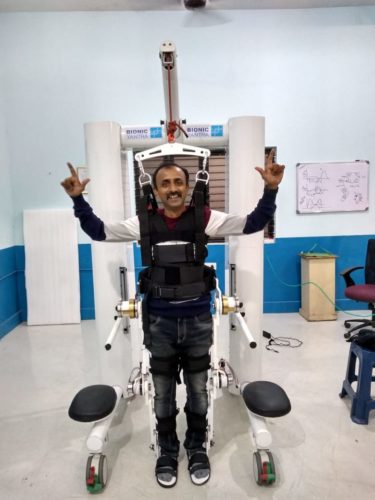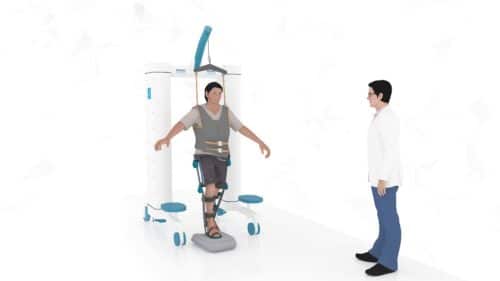We all knew that the Ironman outfit and other robotic wearables would be implemented sometime soon in the future, but little did we expect it would be possible today in India. Today, 15 percent of the world’s population having movement disability and 650 million people having severe mobility disorder and this is expected to increase even more in the coming years. Foreseeing this, Bionic Yantra is working towards building Wearable Robotic Exoskeleton (WRE) that is affordable and enables people to walk.
This Made-In-India product is intended to cater to the needs of the disabled in India and of course other countries. Exoskeletons can be used to stand, walk and assist in performing activities of daily living.
On 30th November, Bionic Yantra in collaboration with Shirley Ryan Ability Lab (SRALAB), a Rehab hospital in the USA and one of the premier institutions for robotic rehabilitation globally hosted a small discussion at Hyatt Central, Bengaluru to talk on the advances in the field of rehabilitation and technology.
This event was attended by various robotic engineers, investors in healthcare, distinguished doctors spanning rehabilitation, neurosurgery, and physiotherapy and the discussion was on what is available today and how can it be implemented in the Indian market.
Shirley Ryan Ability Lab (SRALAB), has been practicing and building robotic products for patients since 1991. “Robotic hands have been available right since the year 1912, which was made up of a hook and bicycle chain. Later in the year 1960, Myoelectric arms were introduced and today we have separate exoskeletons/robots for various parts of the body and any type of disability”, said Dr. Levi Hargrove, Director, Centre of Bionic Medicine, SRALAB, Chicago.
The core electronic parts present in the robot is just a couple of sensors and 4 brushless DC motors. The main challenge with respect to design is matching the control signals and making sure the DC motors rotate perfectly. Matching and configuring it to the patents requirements takes around 5 to 10 minutes.
“Earlier it used to take us an hour or so to customise the equipment to each patient, now it just takes 5-10 minutes”, says Dr. Arun Jayaraman, Director, Max Nader Centre of Rehabilitation and Functional Outcomes, SRALAB, Chicago.
With these practical experiences and real stories, SRALAB is continuing to ease the life of patients with stroke, brain injury, spinal cord injury or any medical disability that affects motion in the US. Searching for the ecosystem that is perfect as well as a company that is already working towards medical robotics, they found Bionic Yantra.
“We were surprised when the products we sell for 250 Dollars is being manufactured at Bionic Yantra within 40000 Rupees”, says Dr. Arun Jayaraman.
“In the Indian market, the scenario is such that 10 Million people in India alone and many millions across the globe cannot walk owing to injuries/diseases such as Spinal Cord Injury and Stroke. We have been talking to various hospitals like MS Ramaiah, Indian Spinal Injury Centre and many more. All are keen to see this technology in action”, says Vaidy Narayanan, Founder, and Director, Bionic India.
Bionic Yantra’s Rehabilitation System will also automate the measurement of patient progress and documentation thus enabling high objectivity and transparency in the rehabilitation of patients in hospitals/medical centers. In addition, advanced approaches such as the Internet of Things and Machine Learning are envisaged to further enrich value to patients and hospitals.
The Exoskeleton is a battery powered “wearable suit” intelligently controlled by a combination of motors, drives, and mechanisms which are programmed to provide calibrated, on-demand assistance and resistance for limb movement as required for rehabilitation and locomotion. There are 2 variants of this product – Rehabilitation System & Personal Mobility Device.
The battery is of Lithium-ion based and is charged for 10000 steps. Also, the team is working on building a system where the battery charges by itself just by standing next to the power source.
What exactly happens here?
The patient is brought to the Robotic Exoskeleton Assisted Rehabilitation System in a wheelchair, and the physiotherapist straps the harness jacket while the patient sits in the wheelchair. The dynamic body weight system is activated to lift the patient using a powered winch and brought to a suitable posture. Then, the exoskeleton is strapped around the patient. This would enable the person to sit, stand or walk on the first day itself. So, while the patient moves the harness with the frame also moves, so even if the patient is about to fall the harness senses and catches the patient. This also reduces the number of physiotherapists required to help a patient.
So, with these super robotic exoskeletons coming up, in future, not just the disabilities but also old age or any sorts of accidents will not be a hindrance to any of your day to day activities.







